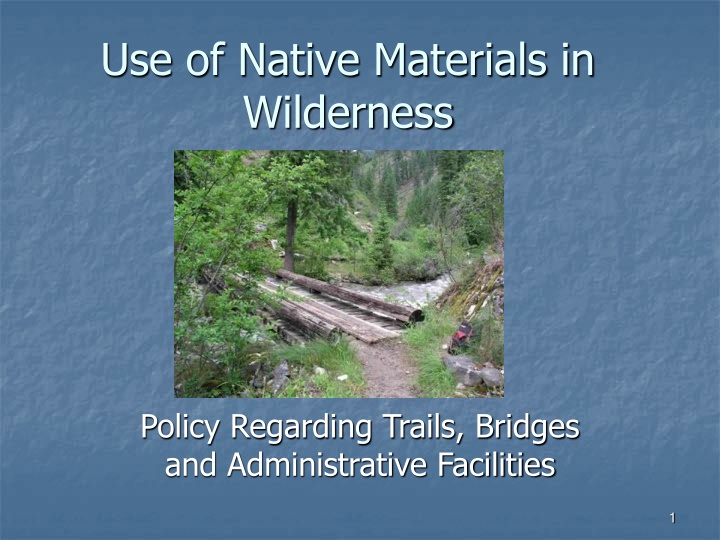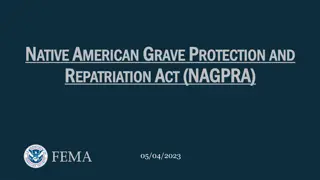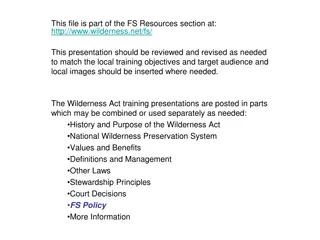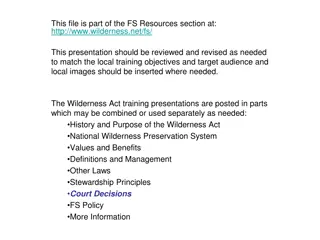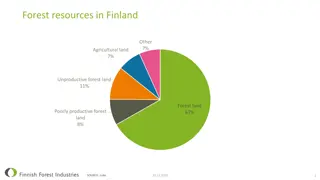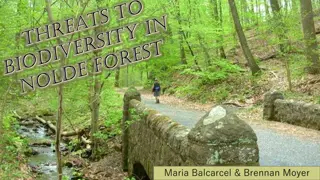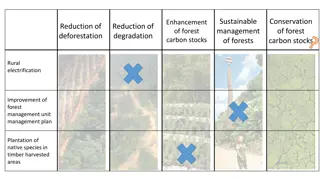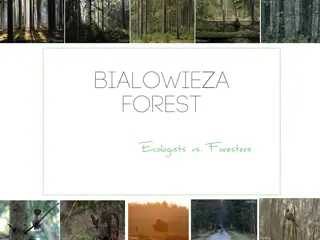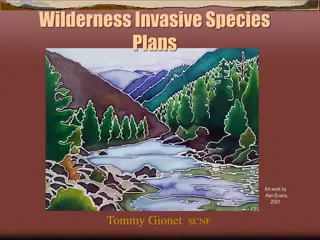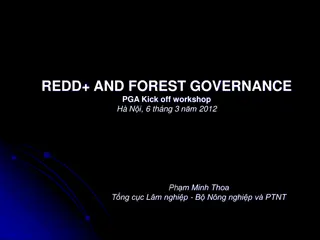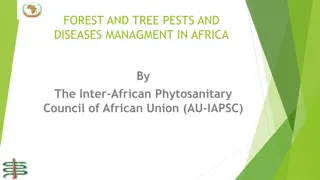Forest Service Policy on Native Materials in Wilderness
This information outlines the use of native materials in wilderness areas, focusing on trails, bridges, and administrative facilities. It covers examples of structures using native materials, common questions surrounding material choices, guidelines for trail and wilderness managers, and Forest Service policies related to the use of native materials in wilderness according to the Wilderness Act, Forest Service Manual, and more.
Download Presentation

Please find below an Image/Link to download the presentation.
The content on the website is provided AS IS for your information and personal use only. It may not be sold, licensed, or shared on other websites without obtaining consent from the author.If you encounter any issues during the download, it is possible that the publisher has removed the file from their server.
You are allowed to download the files provided on this website for personal or commercial use, subject to the condition that they are used lawfully. All files are the property of their respective owners.
The content on the website is provided AS IS for your information and personal use only. It may not be sold, licensed, or shared on other websites without obtaining consent from the author.
E N D
Presentation Transcript
Use of Native Materials in Wilderness Policy Regarding Trails, Bridges and Administrative Facilities 1
Example Structures with Native Material Options Trail Structures: Turnpikes Check dams Culverts Water bars Retaining walls Bridges - many parts, such as: Stringers Decking Handrails Administrative facilities: Buildings Fences Signs and posts 2
Common Questions Use of: Rock or local logs? Local logs or imported logs? Imported logs or dimensional lumber? Pressure treated lumber? (including stringers, decking, railing) Filter fabric in turnpikes? Rock, plastic, or metal culverts? 4
Photos 5
What are Trail and Wilderness Managers to do? What s the policy? 6
Forest Service Policy on Use of Native Materials in Wilderness Wilderness Act Forest Service Manual Trails & Wilderness Forest Service Handbook Trails Forest Plan and/or Wilderness Management Plan for your area Designating legislation for your Wilderness, if applicable Wilderness Recreation Opportunity Spectrum 7
Forest Service Policy on Use of Native Materials in Wilderness 8
Forest Service Policy on Use of Native Materials in Wilderness Nothing directly related to the use of native materials in Wilderness 9
Forest Service Policy on Use of Native Materials in Wilderness Nothing directly related to the use of native materials in Wilderness Plenty of general direction that can be applied to answer questions related to the use of native materials 10
Wilderness Act Section 2 (a): "wilderness areas shall be administered to provide for the preservation of their wilderness character 11
Wilderness Act Section 2 (c):Key phrases - where the earth and its community of life are untrammeled by man.. protected and managed so as to preserve its natural conditions with the imprint of man's work substantially unnoticeable 12
Wilderness Act Section 4 (b): each agency administering any area designated as wilderness shall be responsible for preserving the wilderness character of the area 13
Wilderness Character The four qualities of wilderness related to wilderness character Untrammeled wilderness is essentially unhindered and free from modern human control or manipulation. Natural wilderness ecological systems are substantially free from the effects of modern civilization. Undeveloped wilderness is essentially without permanent improvements or modern human occupation. Outstanding opportunities for solitude or a primitive and unconfined type of recreation . From Monitoring Selected Conditions Related to Wilderness Character: A National Framework 2005 14
FSM CHAPTER 2320 WILDERNESS MANAGEMENT 2320.6 - The Wilderness Management Model and the Wilderness Act The more human influence, the lower the purity of a wilderness is; the less human influence on a wilderness, the higher Manage wilderness toward attaining the highest level of purity in wilderness within legal constraints. 15
FSM CHAPTER 2320 WILDERNESS MANAGEMENT Where a choice must be made preserving the wilderness resource is the overriding value. Economy, convenience, commercial value, and comfort are not standards of management or use of wilderness. Because uses and values on each area vary, management and administration must be tailored to each area 16
FSM CHAPTER 2320 WILDERNESS MANAGEMENT Ensure that other resources and activitieswithin wildernessare coordinated and in harmony with the wilderness resource includ(ing): the trail system 17
FSM CHAPTER 2320 WILDERNESS MANAGEMENT Design, construct, and maintain the transportation system in wilderness to provide access Design and locate trails to fit into the natural landscape as unobtrusively as possible. Design bridges to minimize the impact on the wilderness. 18
FSM CHAPTER 2320 WILDERNESS MANAGEMENT Trees may be cut for use in the construction and maintenance of authorized structures located within the wilderness when it is not reasonably possible to obtain the necessary material from outside the wilderness. 19
FSM 2353 - NATIONAL FOREST SYSTEM TRAILS Provide trail recreation opportunities that emphasize the natural setting Emphasize long-term cost effectivenessand needwhen developing or rehabilitating trail facilities. 20
FSH 2309.18 - TRAILS MANAGEMENT HANDBOOK The objective of trail development is to provide a facility that minimally affects resources , that requires minimal maintenance, and that serves the intended type and level of use. 21
FSH 2309.18 - TRAILS MANAGEMENT HANDBOOK Wilderness Considerations. The standards for trails and waterways within a wilderness will reflect the minimum requirements to achieve the following goals: To construct and maintain the trail and necessary facilities so that they appear to be a part of the wilderness environment and not an intrusion upon it. 22
Wilderness Management Plans Selway-Bitterroot Wilderness General Management Direction The use of metal or plastic culverts is prohibited. 23
So what does all that mean? Lacking specific policy direction regarding the use of native materials, apply the general direction 24
Work together to evaluate each situation and determine what is the appropriate combination of materials to meet both wilderness and trail management objectives. Use the Minimum Requirements Decision Guide for complex projects (see www.wilderness.net for examples) Unique outcomes will result based on the specifics of the situation. 25
Expectations for Wilderness Projects When any Forest Service employee works in Wilderness, they become a Wilderness Manager. The starting point should be to figure out how to accomplish the objective with the minimum necessary materials, tools, transportation, impacts and how to best protect wilderness character. Consider and evaluate all the options: select the combination that results in the least impact to wilderness character and is in conformance with law and policy. 26
Whats your ideal for Wilderness Projects? (from the trails perspective) 27
Cupboard Creek Bridge 30
Bridge photo 31
